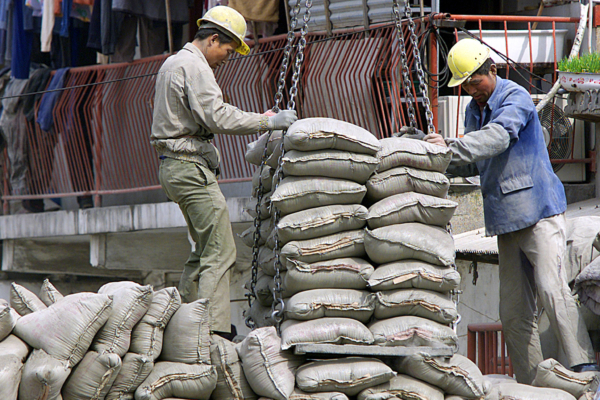China’s economy continues to decline, with the real estate sector in a slump and the cement industry facing internal challenges in recent years. Prices have dropped, profits have plummeted, and cement production in July hit its lowest point since 2009. With overproduction, China’s cement exports saw a significant surge in July.
On August 15, China’s National Bureau of Statistics revealed that cement production in July was 146 million tons, a 5.6% decrease year-on-year. From January to July, cement production totaled 958 million tons, down 4.5% compared to the same period last year.
According to Bloomberg’s analysis of historical data from China’s National Bureau of Statistics, against the backdrop of the unresolved real estate crisis and weak infrastructure construction, China’s cement production in July hit its lowest level since 2009.
The report suggests that few commodities can mirror China’s economic situation as well as humble cement. The decline in production indicates a significant slowdown in China’s construction industry after the frenzy of the past decade. Cement, more than industries like steel, reflects China’s “old economy” as it mainly targets the domestic market and heavily relies on the construction sector.
The report analyzes the reasons for the drop in cement production. Weather played a role as heatwaves and heavy rains affected construction activities. Cement producers were also required by the government to reduce capacity to better align with internal reform needs. However, the main reasons are the ongoing real estate crisis and sluggish infrastructure activities.
The latest economic data released by China’s National Bureau of Statistics on August 15 showed a continued decline in the economy, with industrial activities, investment, and retail sales all falling short of expectations. Steel production hit a new low for the same period since 2017, real estate investment recorded the largest decline since 2020, and Renminbi loans saw their first contraction in 20 years.
Retail sales of real estate in July saw a modest 3.7% year-on-year growth, below the expected 4.6%, with the month-on-month growth rate hitting a new low for the year. New home sales of the top 100 real estate companies in China declined by over 20% for two consecutive months.
Jiang Pinchao, President of the American Prosper Real Estate Investment Company, expressed that it is challenging to boost China’s real estate sector due to the economic downturn. The entire real estate industry and its upstream and downstream industries are in a state of contraction as people are not buying houses, which in turn affects the demand for basic construction materials like cement, as well as other building materials and industries such as home appliances.
Bloomberg notes that cement exports themselves are not substantial, and the surplus concrete construction cannot be shipped overseas like surplus solar panels or cars. However, according to the latest data from the General Administration of Customs of China, in July 2025, China’s export of cement and clinker reached 1.01 million tons, a 117.4% year-on-year increase. From January to July, exports totaled 5.16 million tons, a 60.3% increase year-on-year.
Public data shows that China’s cement export market is mainly concentrated in Asia, with Cambodia, the Philippines, and Mongolia being primary export destinations.
Commentator Li Linyi explained that while China’s cement production hit a multi-year low in July, boosting exports can provide temporary relief but with minimal profits. This situation is largely a result of overproduction following years of aggressive expansion.
The white cement production market in China is highly competitive, with companies such as Jidong Cement, Yutu New Material, Yingshan Shares, Huaxin Cement, and China Building Materials Group playing key roles. Yingshan Shares is a leading enterprise in China’s white silicate cement industry.
Earlier reports from “Jiemian News” in July highlighted the internal challenges facing the cement industry in China. In the first half of 2024, the industry reported its first industry-wide losses since the 21st century, totaling approximately 1.2 billion yuan. Overall profits for the year were around 26 billion yuan, down 16% from 2023. Compared to the peak profit period in 2019, demand has dropped by 22.34%, leading to an 86% decline in total profits, a far cry from previous years.
On August 13, the China Cement Network Information Center reported that the precast concrete industry in Jiangxi Province is facing severe challenges. In 2024, the province saw a 22.8% year-on-year drop in precast concrete production, with a capacity utilization rate of only 18.4%. Revenues declined by 30.2%, narrowing the gap between concrete sales prices and comprehensive costs, nearly erasing profit margins for businesses.
From 1990 to 2014, China’s cement production increased annually for nationwide infrastructure and large-scale real estate construction. The peak of cement production was in May 2020 before the real estate crisis erupted.
Data indicates that from 2015 to 2021, China’s cement industry saw overall revenue growth due to the property boom. Revenue peaked at 1.0754 trillion yuan in 2021 but sharply declined to 888.51 billion yuan in 2022. The national average price of cement has been decreasing since 2022, with prices of 425.86 yuan/ton, 394.25 yuan/ton, and 384 yuan/ton from 2022 to 2024, showing 8% and 2.6% year-on-year decreases in 2023 and 2024 respectively.

